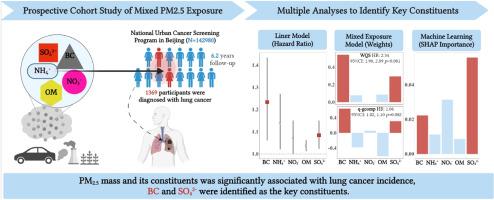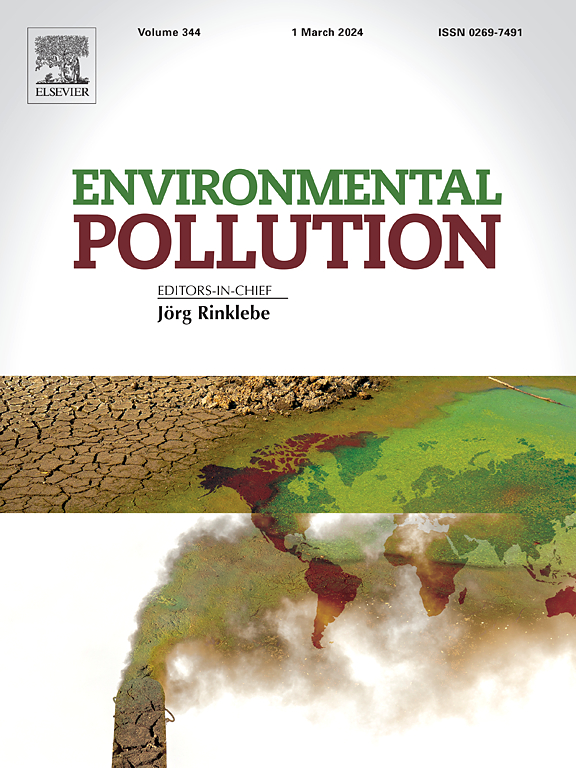长期暴露于细颗粒物及其成分与肺癌发病率之间的关系:来自中国北京一项前瞻性队列研究的证据
IF 7.6
2区 环境科学与生态学
Q1 ENVIRONMENTAL SCIENCES
引用次数: 0
摘要
长期暴露于环境细颗粒物(PM2.5)与肺癌发病率之间的关系已得到充分证明。然而,不同PM2.5成分[黑碳(BC)、铵(NH4+)、硝酸盐(NO3−)、有机物(OM)和无机硫酸盐(SO42−)]的作用尚不清楚。这项研究旨在明确PM2.5成分与肺癌发病率之间的关系。本研究基于北京130,860名参与者的前瞻性队列,利用Cox模型探讨PM2.5成分与肺癌发病率之间的关系。我们进一步使用混合暴露模型[加权分位数和(WQS)和基于分位数的g计算(Qgcomp)]和机器学习模型[带有SHapley加性解释(SHAP)的随机森林模型]来指定每个组成部分的重要性。结果表明,PM2.5质量及其成分与肺癌发病率增加有显著相关。5年平均浓度增加1-μg/m3的风险比(hr)和95%置信区间(CI)分别为:PM2.5质量增加1.01 (95% CI: 1.00, 1.02), BC增加1.23 (95% CI: 1.06, 1.42), NH4+增加1.15 (95% CI: 1.04, 1.27), NO3−增加1.08 (95% CI: 1.02, 1.16), OM增加1.04 (95% CI: 1.01, 1.06), SO42−增加1.08 (95% CI: 1.03, 1.15)。WQS和Qgcomp模型都将BC和SO42−赋予了两个最高的正权重。SHAP分析确定SO42 -和BC分别是第一和第三重要的贡献者。我们的研究结果表明,PM2.5质量及其成分与肺癌发病率显著相关,而BC和SO42-是这些关联的关键成分。本文章由计算机程序翻译,如有差异,请以英文原文为准。


Associations between long-term exposure to fine particulate matter and its constituents with lung cancer incidence: Evidence from a prospective cohort study in Beijing, China
Association between long-term exposure to ambient fine particulate matter (PM2.5) and lung cancer incidence is well-documented. However, the role of different PM2.5 constituents [black carbon (BC), ammonium (NH4+), nitrate (NO3−), organic matter (OM), and inorganic sulfate (SO42−)] remain unclear. The study aimed to specify the associations between PM2.5 constituents and lung cancer incidence. Based on a prospective cohort of 130,860 participants in Beijing, the present study utilized Cox model to explore the associations between PM2.5 constituents and lung cancer incidence. We further used mixed exposure models [weighted quantile sum (WQS) and quantile-based g-computation (Qgcomp)] and machine learning model [random forest model with SHapley Additive exPlanations (SHAP)] to specify the importance of each constituent. Results indicated that PM2.5 mass and its constituents were significantly associated with increased lung cancer incidence. The hazard ratios (HRs) and 95% confidence intervals (CIs) of 1-μg/m3 increase in the 5-year average concentrations were 1.01 (95% CI: 1.00, 1.02) for PM2.5 mass, 1.23 (95% CI: 1.06, 1.42) for BC, 1.15 (95% CI: 1.04, 1.27) for NH4+, 1.08 (95% CI: 1.02, 1.16) for NO3−, 1.04 (95% CI: 1.01, 1.06) for OM, and 1.08 (95% CI: 1.03, 1.15) for SO42−. Both the WQS and Qgcomp models assigned the two highest positive weights to BC and SO42−. SHAP analysis identified SO42− and BC as the first and third most important contributors, respectively. Our results indicated that PM2.5 mass and its constituents were significantly associated with lung cancer incidence, and BC and SO42− were the key constituents in these associations.
求助全文
通过发布文献求助,成功后即可免费获取论文全文。
去求助
来源期刊

Environmental Pollution
环境科学-环境科学
CiteScore
16.00
自引率
6.70%
发文量
2082
审稿时长
2.9 months
期刊介绍:
Environmental Pollution is an international peer-reviewed journal that publishes high-quality research papers and review articles covering all aspects of environmental pollution and its impacts on ecosystems and human health.
Subject areas include, but are not limited to:
• Sources and occurrences of pollutants that are clearly defined and measured in environmental compartments, food and food-related items, and human bodies;
• Interlinks between contaminant exposure and biological, ecological, and human health effects, including those of climate change;
• Contaminants of emerging concerns (including but not limited to antibiotic resistant microorganisms or genes, microplastics/nanoplastics, electronic wastes, light, and noise) and/or their biological, ecological, or human health effects;
• Laboratory and field studies on the remediation/mitigation of environmental pollution via new techniques and with clear links to biological, ecological, or human health effects;
• Modeling of pollution processes, patterns, or trends that is of clear environmental and/or human health interest;
• New techniques that measure and examine environmental occurrences, transport, behavior, and effects of pollutants within the environment or the laboratory, provided that they can be clearly used to address problems within regional or global environmental compartments.
 求助内容:
求助内容: 应助结果提醒方式:
应助结果提醒方式:


